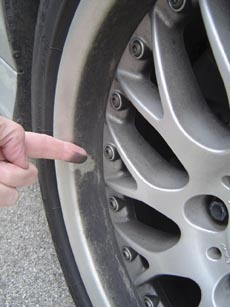By Larry Carley
Nothing looks worse than a relatively clean $50,000 car with black, grimy wheels. European luxury sedans are notorious for having dirty front wheels because of the black dust that’s generated by their disc brake pads. The dust sticks to the alloy wheels giving them an unsightly appearance.
 Europeans use different friction materials than their domestic counterparts because they want their brakes to be quiet, as well as hard working. The trade-off is often increased dusting because of the black ingredients that are in the pads.
Europeans use different friction materials than their domestic counterparts because they want their brakes to be quiet, as well as hard working. The trade-off is often increased dusting because of the black ingredients that are in the pads.
Domestic vehicle manufacturers also want good performance and quiet operation, but many use ceramic-based friction materials that produce less visible dust. The dust is still there, but it’s harder to see because the compounds are usually a lighter color. And dust from many ceramic-based friction materials is less “clingy” and doesn’t form a heavy coating on alloy wheels. Consequently, the wheels stay cleaner longer.
The purpose of this article is not to compare the relative merits of one type of friction compound to another, but to make our readers aware of the fact that there are alternatives to the OEM high-dust black pads that are used on many European vehicles, as well as some domestic cars and trucks. A growing number of aftermarket brake suppliers now have "low-dusting" formulas that improve wheel cosmetics, as well as brake performance.
There’s no way to eliminate brake dust entirely because all friction linings are designed to wear. If the pads didn’t wear, they’d soon chew up the rotors — and pads are a lot cheaper to replace than rotors.
Relatively soft nonasbestos organic (NAO) friction materials typically wear more than harder semi-metallic compounds. It’s hard to generalize about the wear characteristics of ceramic-based compounds because there are so many. Wear rates vary depending on the formula the friction supplier chooses for a particular application. Different vehicles require different coefficients of friction, so formulas are often "application engineered" to deliver the best combination of stopping power, wear resistance, pedal feel and noise control. Most premium-quality ceramic-based linings will provide long life and wear less than an equivalent set of NAO pads on the same application. So, the next time you have a customer who complains about ugly brake dust sticking to his wheels, you can recommend replacing the old dirty pads with low-dusting, ceramic-based pads. By the same token, you can reduce the risk of future dust complaints by installing low-dusting pads when you change the pads during a normal brake job.
Another way to reduce brake dust buildup on wheels is to install dust shields between the wheel and hub. Shields deflect dust away from the wheel so it can’t stick and form an ugly coating. Shields are relatively inexpensive and easy to install. But some people have raised concerns about these products blocking or restricting air flow to the brakes.
Brakes do generate a lot of heat, and the more aggressive the vehicle is driven, the more cooling the brakes need to prevent brake fade. When too much heat builds up in the pads and rotors, it reduces friction and increases the pedal pressure required to stop the vehicle. In extreme situations (as when driving down a steep mountain and riding the brakes mile after mile), the brakes may get so hot they fail altogether.
We’ve never heard of this happening under normal use on a vehicle that has been equipped with dust shields, but it may be a legitimate concern in a "severe-duty" situation. If a customer wants dust shields, the best advice would be to buy ones that have vents. The vents allow some airflow, but keep most of the dust away from the wheels.
What’s the best way to remove brake dust from dirty wheels? Hot soapy water or a cleaner that is specifically formulated for wheels, plus a soft bristle or foam brush and plenty of scrubbing will usually do a good job of removing the dust. Harsh cleaning chemicals or abrasive compounds, such as scouring powder, should never be used on alloy wheels. Nor should you ever use a brush with wire bristles or extremely hard plastic bristles. Scratching through the clear-coat finish will open a direct route for corrosion to attack the aluminum.
There are aerosol wheel cleaning products that are safe for aluminum wheels, and many claim to require little or no scrubbing. Just spray it on and rinse or wipe it off. It’s as easy as that. To keep clean wheels clean, the buildup of brake dust can be reduced by applying a coating of wax or polymer-based protectant, or a spray-on wheel treatment. The coating will reduce the tendency of brake dust to stick to the wheels while enhancing the wheel’s appearance.











